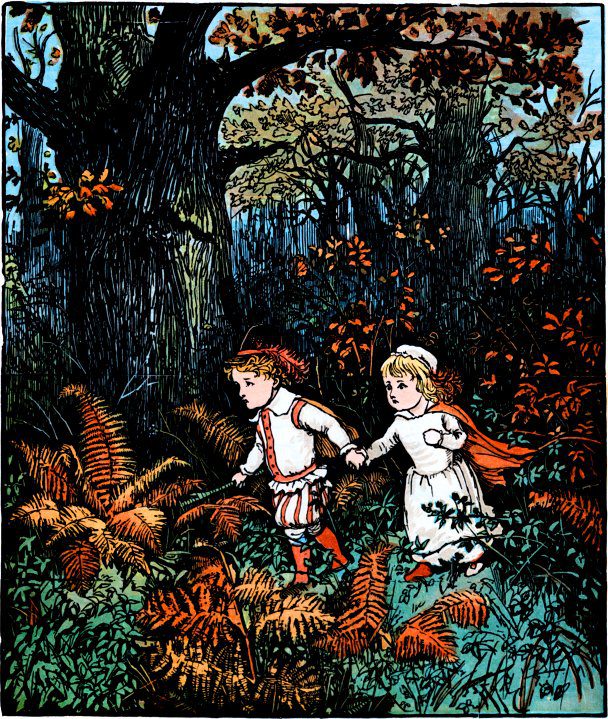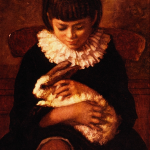
In the quaint village of Woolpit, England, an extraordinary tale has echoed through the ages. This story, rich with mystery and intrigue, has captured the imaginations of countless generations. It’s the story of the Green Children of Woolpit, an unusual legend from the 12th century. But what’s the real story behind these enigmatic figures? And how has their tale influenced art and literature through the centuries? Let’s dive into the mystery of the Green Children of Woolpit.
The Mysterious Appearance of the Green Children
The story begins in the medieval village of Woolpit, located in Suffolk, England. During the reign of King Stephen, around the mid-12th century, villagers stumbled upon something utterly bizarre. Two children, a boy and a girl, were found near one of the wolf pits from which the village gets its name. These children were unlike anything the villagers had ever seen.
First and foremost, the children’s skin was green. This strange hue set them apart immediately. Moreover, they spoke a language that no one could understand. Their clothing was also unusual, made of materials unfamiliar to the villagers. The children seemed lost and confused, leading the locals to question where they had come from.
Despite the initial shock, the villagers took the children in. They were treated with care, though the villagers remained curious and somewhat wary. Over time, the children were taught English, and their story began to unfold. According to the girl, they came from a land where the sun never shone brightly, and everything was in a perpetual twilight. This land, she claimed, was called “St. Martin’s Land.”
The Land of Perpetual Twilight: St. Martin’s Land
St. Martin’s Land, as described by the green children, was a place of eternal dusk. The light there was dim, and the sun never fully rose. The people in this land lived underground, surrounded by a strange, greenish light that seemed to permeate everything. It’s this light, according to the children, that gave their skin its unusual color.
But where exactly was this mysterious land? The children couldn’t provide a clear answer. Some have speculated that they might have come from a subterranean world, accessed through hidden caverns or tunnels. Others suggest that St. Martin’s Land could have been a faraway region, perhaps an isolated area where environmental factors caused the green hue in their skin.
Interestingly, the green children spoke of a river that separated their world from ours. One day, while tending their family’s flock, the children heard a loud noise and were suddenly swept across this river into a bright, unfamiliar land. Disoriented, they wandered until they were found by the villagers of Woolpit. This tale has led to endless speculation about whether the children’s origins were supernatural or if there was a more rational explanation.
The Fate of the Green Children: Assimilation and Tragedy
As time passed, the green children became part of the Woolpit community. However, their journey was not without its hardships. The boy, unfortunately, became ill and died shortly after their arrival. The girl, on the other hand, adapted to her new life. She lost her green coloring as she grew accustomed to the food and lifestyle of the villagers.
Eventually, the girl was baptized and learned to speak English fluently. She integrated into society and even took on the name “Agnes.” Although she never returned to her homeland, Agnes lived a relatively normal life in Woolpit. She worked as a servant in a local household and later married a man from King’s Lynn, a nearby town.
Yet, despite her apparent assimilation, the story of her origins remained a topic of fascination. Many wondered whether her tale was true or a clever fabrication. Some speculated that the children were from a Flemish immigrant family who had fled from violence, explaining their unusual appearance and language. However, this theory never fully explained the green skin or the otherworldly elements of their story.
Artistic Interpretations of the Green Children
The mystery of the green children didn’t fade with time. Instead, it inspired a wealth of artistic interpretations across various mediums. Painters, writers, and poets found the tale captivating, each adding their own spin to the legend.
One of the earliest artistic depictions of the green children appears in a painting by the 16th-century artist, Lucas Cranach the Elder. His work often explored fantastical themes, and the story of the green children fit perfectly into his oeuvre. In his painting, Cranach captures the eerie atmosphere surrounding the children’s discovery, emphasizing their otherworldly appearance.
Moving into the 19th century, the story of the green children took on new life in literature. William Morris, a prominent figure in the Arts and Crafts Movement, referenced the tale in his poem “The Earthly Paradise.” Morris’s version of the story leans heavily on the mysterious and mythical aspects, weaving a narrative that blurs the lines between reality and fantasy.
In more recent times, the story has influenced modern fiction. Writers such as Herbert Read and John Macklin have drawn from the legend, using it as a foundation for stories that explore themes of alienation, otherness, and the supernatural. These contemporary interpretations often focus on the psychological aspects of the tale, delving into the fear and fascination that the unknown can evoke.
The Influence of the Green Children in Literature
The Green Children of Woolpit have left an indelible mark on literature, inspiring countless authors to explore their story in depth. The tale’s blend of mystery, otherworldliness, and tragedy provides fertile ground for literary exploration. As a result, writers across centuries have found ways to incorporate the green children into their works.
In the 12th century, historian William of Newburgh recorded the tale in his work, “Historia rerum Anglicarum.” His account is one of the earliest written records of the story. While he expressed skepticism, William acknowledged the strangeness of the tale and its potential significance. This record helped preserve the story, allowing future generations to discover and reinterpret it.
Centuries later, in the 17th century, the story appeared in Ralph of Coggeshall’s “Chronicon Anglicanum.” Ralph’s version is similar to William’s but adds more detail, further cementing the tale in the annals of English folklore. His work also contributed to the story’s enduring appeal, as it was passed down through the generations.
In the 19th century, the Green Children of Woolpit experienced a literary revival. Writers like James William Barlow and Robert Burton wove the story into their works, using it as a symbol of the unknown and the supernatural. Their interpretations often highlighted the darker aspects of the tale, focusing on the fear and uncertainty that the green children represented.
In modern times, science fiction and fantasy writers have embraced the story, using it as a jumping-off point for more expansive narratives. The tale’s ambiguity allows for a wide range of interpretations, making it a perfect fit for genres that thrive on imagination and speculation. Authors like Graham Joyce and Mary Stewart have drawn from the legend, exploring themes of parallel worlds, lost civilizations, and the boundaries between reality and fantasy.
Theories Behind the Green Children
The story of the Green Children of Woolpit has inspired many theories over the years. Some theories lean towards the supernatural, while others attempt to provide a more rational explanation. Let’s explore some of the most popular ideas surrounding the mystery.
One of the most commonly cited theories is that the children were extraterrestrial beings. Their green skin, strange language, and unfamiliar clothing have led some to speculate that they were visitors from another planet. Proponents of this theory suggest that the children accidentally ended up on Earth due to a malfunction or miscalculation, leading to their unexpected arrival in Woolpit.
Another theory proposes that the children were from a parallel universe or a hidden realm within our own world. The idea of St. Martin’s Land as a place of perpetual twilight and underground dwellings aligns with certain mythological concepts of hidden worlds. According to this theory, the children somehow crossed a boundary between their world and ours, resulting in their sudden appearance in Woolpit.
A more grounded theory suggests that the children were refugees from a nearby region, possibly Flemish immigrants. During the 12th century, there were reports of Flemish settlers being persecuted in England. The children’s green skin could have been a result of malnutrition, and their language might have been a Flemish dialect unfamiliar to the villagers. This theory, while plausible, doesn’t fully account for the more fantastical elements of the story.
Finally, some believe that the story of the Green Children of Woolpit is a metaphor or allegory. In this interpretation, the green children represent the fear of the unknown and the challenges of integrating with a foreign culture. Their story may have been a way for the villagers to process their anxieties about outsiders and the mysterious nature of the world beyond their village.
How the Green Children Inspired Modern Art
The tale of the Green Children of Woolpit has continued to inspire modern artists, much like it did in centuries past. The mystery and otherworldliness of the story provide a rich canvas for artistic expression, allowing contemporary creators to explore the legend in new and innovative ways.
In visual arts, the story has been interpreted through various mediums, from paintings to sculptures. Artists like Michael Ayrton, known for his explorations of myth and legend, have drawn inspiration from the green children. Ayrton’s works often delve into themes of transformation and otherness, making the story of the green children a perfect subject for his art.
Similarly, contemporary painter Sophie Ryder has created pieces that reference the legend. Ryder’s work often explores the intersection of the human and the animal, blending elements of myth and reality. Her depictions of the green children highlight their alien nature while also emphasizing their humanity, creating a powerful commentary on the story’s enduring relevance.
In literature, the story continues to be a source of inspiration. Novels, short stories, and poems have all drawn from the legend, using it as a framework to explore broader themes. For example, Neil Gaiman, a modern master of fantasy, has referenced the tale in his work. Gaiman’s stories often blend the mundane with the magical, making the legend of the green children an ideal fit for his narrative style.
Music, too, has not been untouched by the legend. Folk songs and modern compositions have been inspired by the story, with musicians using the tale’s haunting qualities to create evocative pieces. These musical interpretations often focus on the mysterious and tragic elements of the story, drawing listeners into the eerie world of the green children.
The Legacy of the Green Children of Woolpit
The Green Children of Woolpit have left a lasting legacy, not just in the village where they were found but in the broader cultural landscape. Their story has transcended its origins, becoming a symbol of the unknown and the mysterious. But what exactly is it about this tale that continues to captivate people after so many centuries?
Part of the story’s enduring appeal lies in its ambiguity. The legend of the green children is filled with unanswered questions and unexplained phenomena. This uncertainty invites speculation and imagination, allowing each generation to reinterpret the story in their own way. Whether seen as a tale of extraterrestrial visitors, a metaphor for cultural assimilation, or a glimpse into a hidden world, the story of the green children offers something for everyone.
The story also resonates because it touches on universal themes. The fear of the unknown, the challenges of integrating into a new society, and the mysteries of the world are all elements that continue to be relevant today. The green children’s journey from outsiders to members of the Woolpit community mirrors the experiences of many who have had to adapt to new environments and cultures.
Finally, the story’s connection to art and literature has helped to preserve and propagate it over the centuries. By inspiring works of art, literature, and music, the tale of the green children has ensured its place in cultural history. Each new interpretation of the story adds another layer to its legacy, keeping the legend alive for future generations.
Conclusion
The strange tale of the Green Children of Woolpit is a story that defies easy explanation. It’s a tale that has intrigued and mystified people for centuries, inspiring countless artistic and literary works. From their mysterious origins in St. Martin’s Land to their assimilation into the Woolpit community, the green children’s story is one of the most enduring legends in English folklore.
While we may never know the full truth behind the green children, their legacy continues to live on. The story’s blend of mystery, tragedy, and otherworldliness ensures that it will remain a source of fascination for generations to come. As we explore the unknown and the unexplained, the tale of the Green Children of Woolpit serves as a reminder that some mysteries are meant to endure, inviting us to wonder and imagine the possibilities that lie beyond our understanding.




